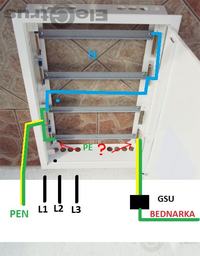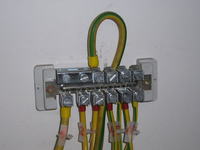Hello.
I have a problem because I am helping my colleague install electrical wiring in a single-family house. According to the conditions, the house will be connected to the TNC network. The arrival will be in a separate outbuilding about 30m from the house, there will be a meter. I have a question about how to properly connect the switchgear at home. If the PEN conductor is separated at the meter, is the connection method in Figure 1 correct? And if the division is only in the switchgear at home, is the fig. 2 correct. I would like to add that I want to divide it into the TNS network. I would like to add that the cooperage is connected to the foundations of the building and the lightning rod. Where to place the gsu strip? How to connect the hoop iron from the outside of the building to the switchgear? Can I use a rail under the switchgear? Can I immediately connect to the rail in the switchgear? because I read somewhere that it should be done? Is it necessary? What cable should I use for this?
I count on your understanding in responses


I have a problem because I am helping my colleague install electrical wiring in a single-family house. According to the conditions, the house will be connected to the TNC network. The arrival will be in a separate outbuilding about 30m from the house, there will be a meter. I have a question about how to properly connect the switchgear at home. If the PEN conductor is separated at the meter, is the connection method in Figure 1 correct? And if the division is only in the switchgear at home, is the fig. 2 correct. I would like to add that I want to divide it into the TNS network. I would like to add that the cooperage is connected to the foundations of the building and the lightning rod. Where to place the gsu strip? How to connect the hoop iron from the outside of the building to the switchgear? Can I use a rail under the switchgear? Can I immediately connect to the rail in the switchgear? because I read somewhere that it should be done? Is it necessary? What cable should I use for this?
I count on your understanding in responses






